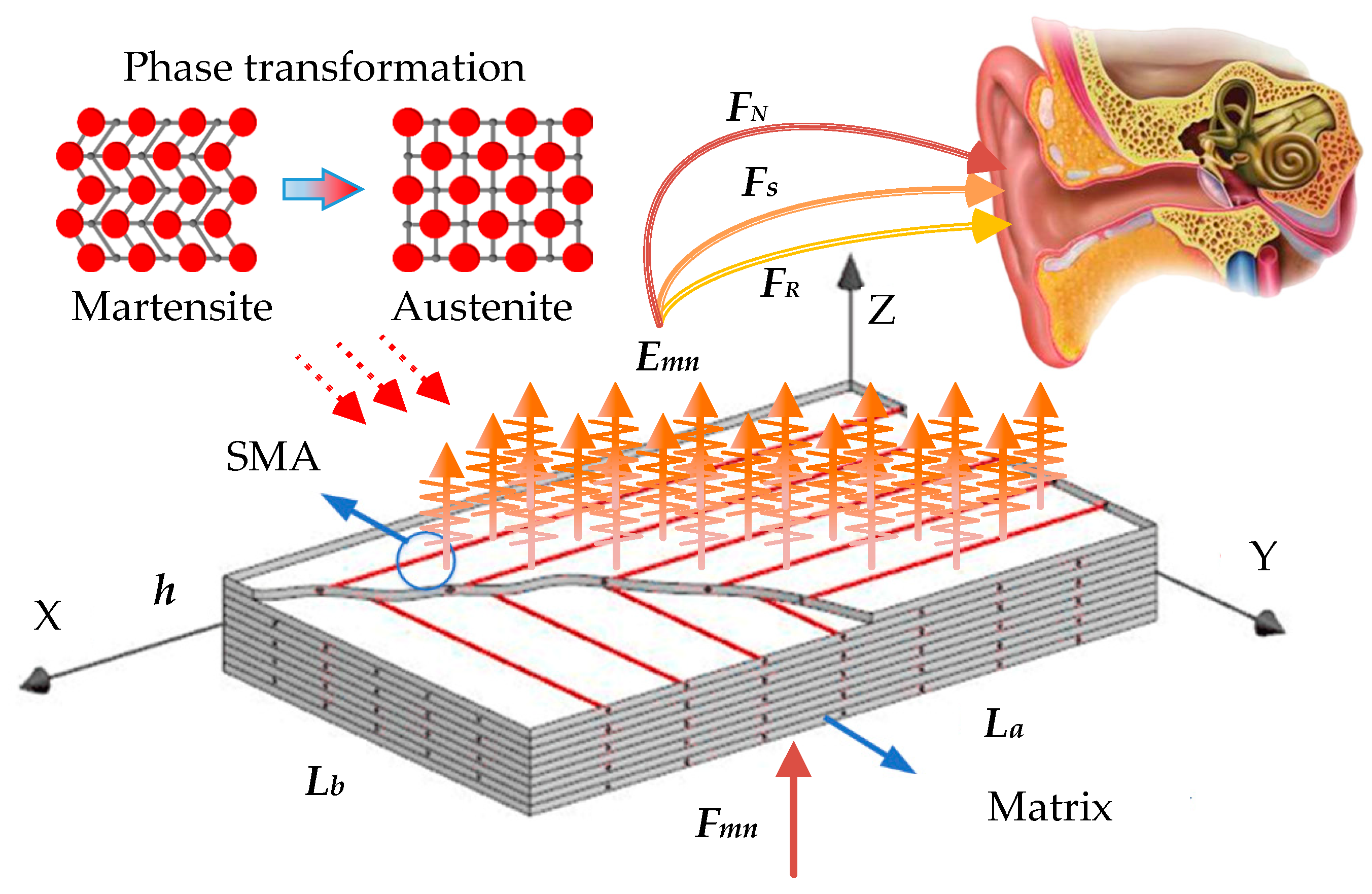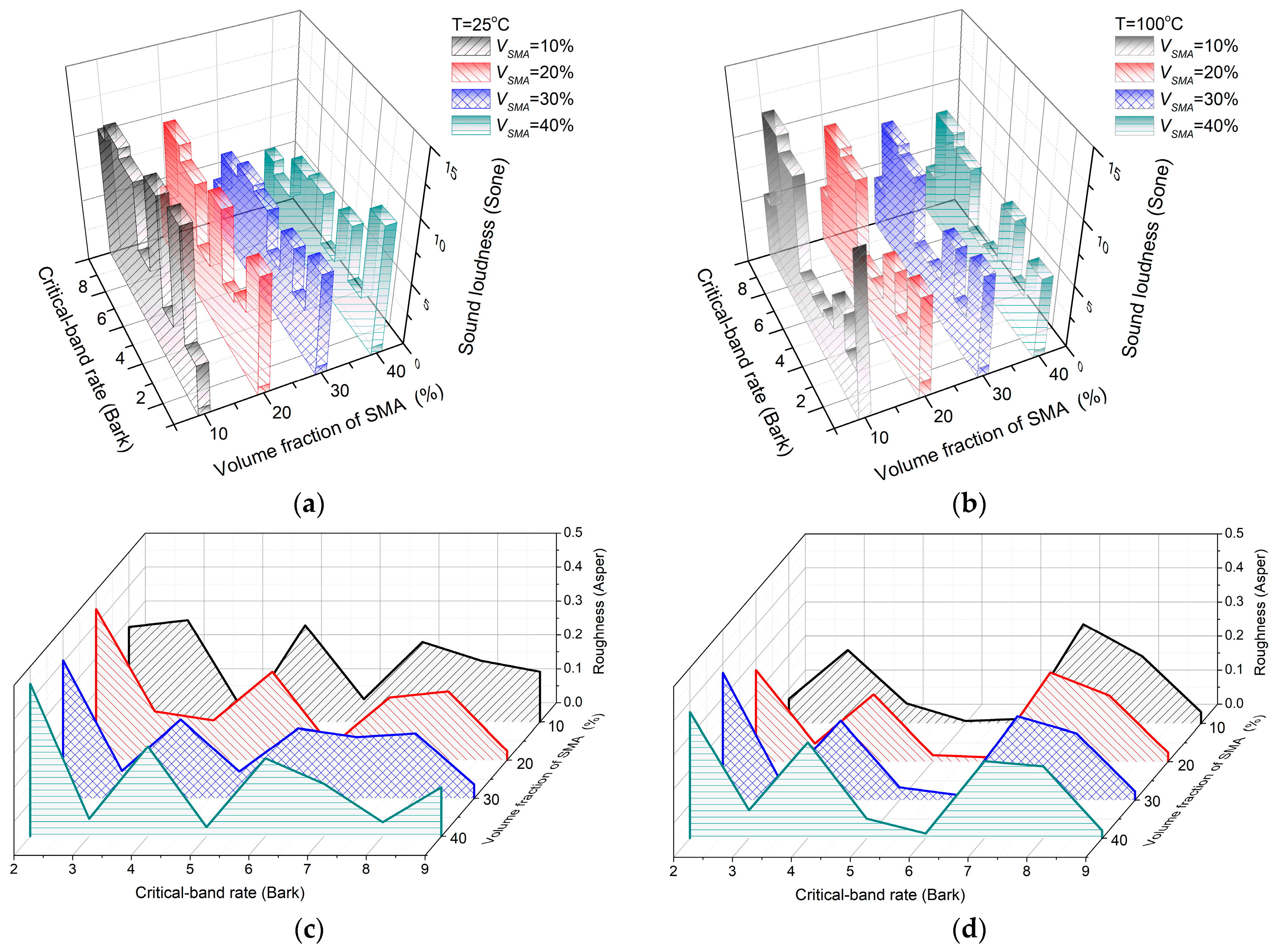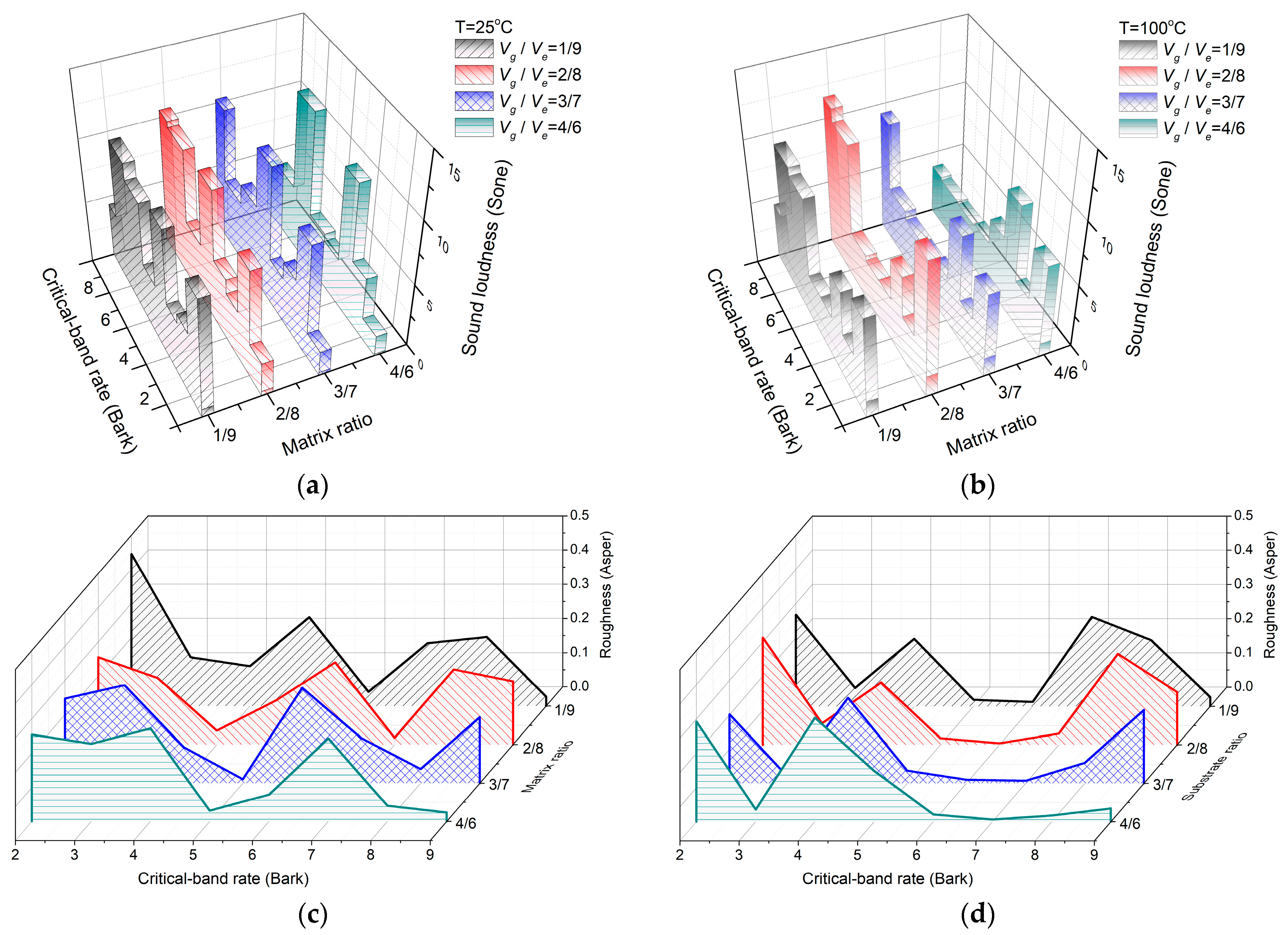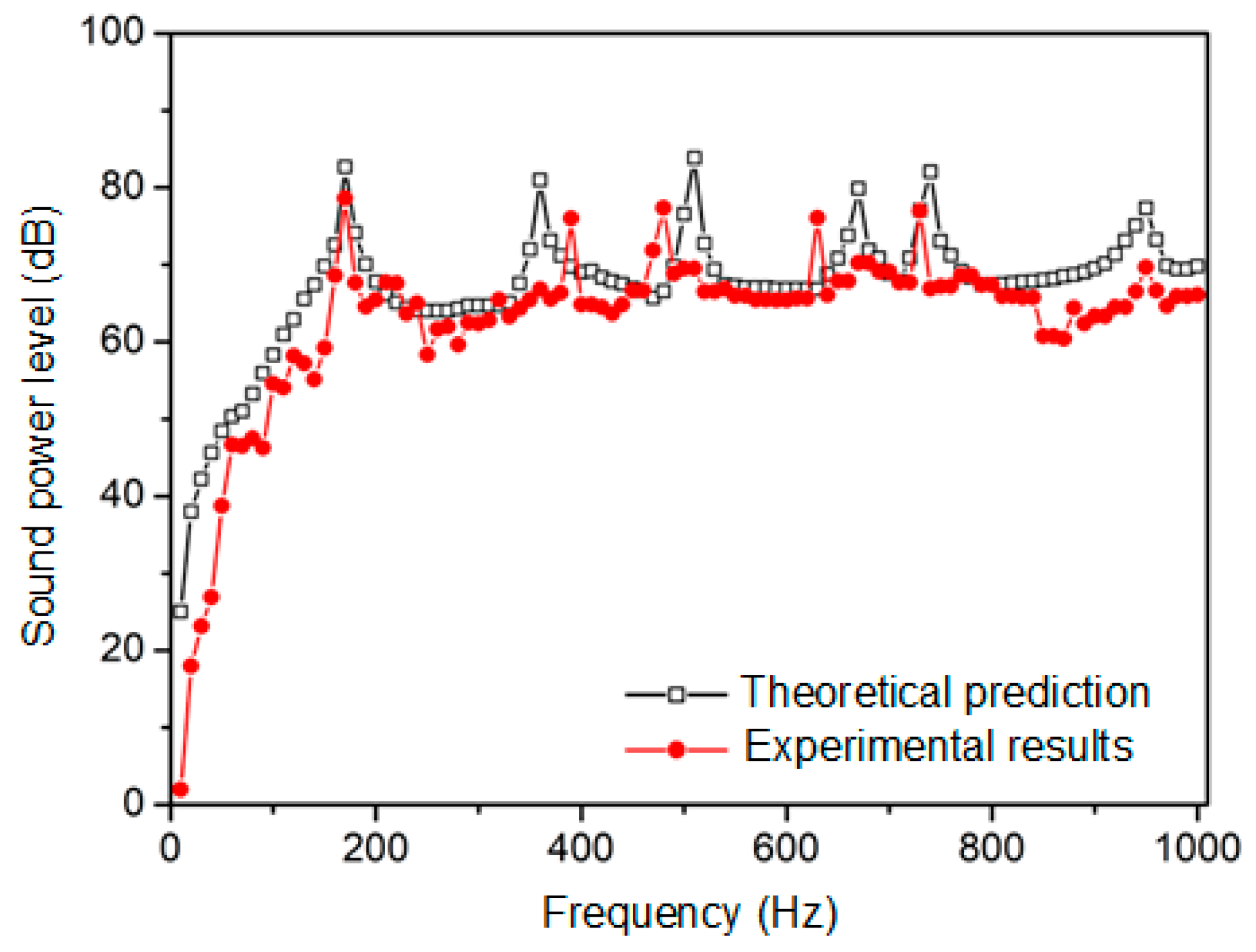Sound Quality Performance of Orthogonal Antisymmetric Composite Laminates Embedded with SMA Wires
Abstract
:1. Introduction
2. Formulation of Sound Quality Evaluation
3. Results and Discussion
4. Experimental Verification
5. Conclusions
- (1)
- At 25 °C ambient temperatures, a variation in SMA tensile pre-strain has little effect on sound loudness, sharpness, or roughness. The loudness and roughness are slightly reduced, while the SMA tensile pre-strain is increased to 5%. At 100 °C, loudness, sharpness, and roughness are all positively correlated with the tensile pre-strain of the SMAs.
- (2)
- Loudness and sharpness at temperatures of 25 °C and high temperatures of 100 °C significantly decline as the SMA volume fraction increases. At 25 °C, the roughness gradually decreases as the volume fraction increases. At 100 °C, the roughness increases gradually with the volume fraction, though less so than at 25 °C.
- (3)
- In the frequency range of 1000 Hz, the number of Barks with loudness greater than 9 for different matrix materials at 25 °C is higher than that at the high temperature of 100 °C. When the ratio of the matrix material is 2:8, the high loudness value distributes more in the high-frequency component and the sharp value is higher. The sound radiation roughness of different matrix material volume fractions at 25 °C is higher than that at 100 °C.
Author Contributions
Funding
Institutional Review Board Statement
Informed Consent Statement
Data Availability Statement
Conflicts of Interest
References
- Cho, W.-H.; Shin, S.-H.; Ih, J.-G. Sound quality change of the automotive engine noise by variation of engine oil condition. J. Mech. Sci. Technol. 2022, 36, 4935–4942. [Google Scholar] [CrossRef]
- Liu, Z.; Gao, D.; Gao, Y.; Yang, J. Numerical and experimental-aided framework based on TPA for acoustic contributions of individual transfer paths on a vehicle door in the slamming event. Appl. Acoust. 2023, 203, 109220. [Google Scholar] [CrossRef]
- Ni, Z.; He, D.; Wang, X.; Zhang, Y. Research on the detection of axle abnormal noise based on maximum autocorrelation kurtosis deconvolution. Appl. Acoust. 2023, 203, 109228. [Google Scholar] [CrossRef]
- Park, J.H.; Park, H.; Kang, Y.J. A study on sound quality of vehicle engine sportiness using factor analysis. J. Mech. Sci. Technol. 2020, 34, 3533–3543. [Google Scholar] [CrossRef]
- Fu, J.; Zhu, C.; Su, J. Research on the Design Method of Pure Electric Vehicle Acceleration Motion Sense Sound Simulation System. Appl. Sci. 2022, 13, 147. [Google Scholar] [CrossRef]
- Hu, Y.; Xu, L.; Wang, S.; Gu, Z.; Tang, Z. Mobile Device-Based Train Ride Comfort Measuring System. Appl. Sci. 2022, 12, 6904. [Google Scholar] [CrossRef]
- Mughal, H.; Sivayogan, G.; Dolatabadi, N.; Rahmani, R. An efficient analytical approach to assess root cause of nonlinear electric vehicle gear whine. Nonlinear Dyn. 2022, 110, 3167–3186. [Google Scholar] [CrossRef]
- Ruan, P.; Zheng, X.; Qiu, Y.; Hao, Z. A Binaural MFCC-CNN Sound Quality Model of High-Speed Train. Appl. Sci. 2022, 12, 12151. [Google Scholar] [CrossRef]
- Yu, Y.; Zheng, X.; Liu, L.; Qiu, Y.; Dai, Z.; Cui, Y. Auditory performance of reproduced sound field in aircraft cabin mock-up by feedback controlled multichannel least-square equalization method. Build. Environ. 2023, 231, 110036. [Google Scholar] [CrossRef]
- Qian, K.; Hou, Z.; Sun, D. Sound Quality Estimation of Electric Vehicles Based on GA-BP Artificial Neural Networks. Appl. Sci. 2020, 10, 5567. [Google Scholar] [CrossRef]
- Huang, H.; Huang, X.; Ding, W.; Yang, M.; Yu, X.; Pang, J. Vehicle vibro-acoustical comfort optimization using a multi-objective interval analysis method. Expert Syst. Appl. 2023, 213, 119001. [Google Scholar] [CrossRef]
- Chen, W.; Lu, C.; Liu, Z.; Williams, H.; Xie, L. A computationally efficient active sound quality control algorithm using local secondary-path estimation for vehicle interior noise. Mech. Syst. Signal Process. 2022, 168, 108698. [Google Scholar] [CrossRef]
- Liao, Y.; Huang, H.; Chang, G.; Luo, D.; Xu, C.; Wu, Y.; Tang, J. Research on Low-Frequency Noise Control of Automobiles Based on Acoustic Metamaterial. Materials 2022, 15, 3261. [Google Scholar] [CrossRef] [PubMed]
- Wang, X.L.; Song, Y.C.; Wang, T.Z.; Wang, Y.S.; Liu, N.N. Hybrid vibro-acoustic active control method for vehicle interior sound quality under high-speed. Appl. Acoust. 2022, 186, 108419. [Google Scholar] [CrossRef]
- Zhang, S.; Zhang, L.; Meng, D.; Pi, X. Active control of vehicle interior engine noise using a multi-channel delayed adaptive notch algorithm based on FxLMS structure. Mech. Syst. Signal Process. 2023, 186, 109831. [Google Scholar] [CrossRef]
- Kim, S.Y.; Ryu, S.C.; Jun, Y.D.; Kim, Y.C.; Oh, J.S. Methodology for Sound Quality Analysis of Motors for Automotive Interior Parts through Subjective Evaluation. Sensor 2022, 22, 6898. [Google Scholar] [CrossRef]
- Grigg, S.; Al-Shibaany, Z.Y.A.; Pearson, M.R.; Pullin, R.; Calderbank, P. Acoustic Sensing and Noise Identification of a Heating, Ventilation and Air Conditioning Unit: Industrial Case Study. Appl. Sci. 2021, 11, 9811. [Google Scholar] [CrossRef]
- Li, B.; Lu, Q.; Jiang, B.; Yang, J.; Wang, J.; Xie, J. Effects of Outer Edge Bending on the Aerodynamic and Noise Characters of Axial Fan for Air Conditioners. Processes 2022, 10, 686. [Google Scholar] [CrossRef]
- Liu, X.; Zhao, D.; Guan, D.; Becker, S.; Sun, D.; Sun, X. Development and progress in aeroacoustic noise reduction on turbofan aeroengines. Prog. Aerosp. Sci. 2022, 130, 100796. [Google Scholar] [CrossRef]
- Wang, J.; Yang, M.; Liang, F.; Feng, K.; Zhang, K.; Wang, Q. An Algorithm for Painting Large Objects Based on a Nine-Axis UR5 Robotic Manipulator. Appl. Sci. 2022, 12, 7219. [Google Scholar] [CrossRef]
- Ruth, D.J.S.; Sohn, J.W.; Dhanalakshmi, K.; Choi, S.B. Control Aspects of Shape Memory Alloys in Robotics Applications: A Review over the Last Decade. Sensors 2022, 22, 4860. [Google Scholar] [CrossRef] [PubMed]
- Hmede, R.; Chapelle, F.; Lapusta, Y. Review of Neural Network Modeling of Shape Memory Alloys. Sensors 2022, 22, 5610. [Google Scholar] [CrossRef]
- Placinta, C.; Stanciu, S.; Panainte-Lehadus, M.; Mosnegutu, E.; Nedeff, F.; Nedeff, V.; Tomozei, C.; Petrescu, T.C.; Agop, M. Theoretical and Experimental Designs on Several Mechanical Properties of Cu-Al-Zn Shape Memory Alloys Used in the Processing Industry. Materials 2023, 16, 1441. [Google Scholar] [CrossRef]
- Santosh, S.; Nithyanandh, G.; Ashwath, J.; Lalith Kishore, K. Comparison of internal friction measurements on Ni-Ti reinforced smart composites prepared by additive manufacturing. J. Alloys Compd. 2022, 924, 166027. [Google Scholar] [CrossRef]
- Sattari, M.; Kadkhodaei, M.; Akbarzadeh, S.; Gholami, R.; Beheshti, A. Wear in superelastic shape memory alloys: A thermomechanical analysis. Wear 2022, 488–489, 204139. [Google Scholar] [CrossRef]
- Sun, M.; Chang, M.; Wang, Z.; Li, H.; Sun, X. Experimental and Simulation Study of Low-Velocity Impact on Glass Fiber Composite Laminates with Reinforcing Shape Memory Alloys at Different Layer Positions. Appl. Sci. 2018, 8, 2405. [Google Scholar] [CrossRef]
- Liu, Y.; Wang, Z.; Li, H.; Sun, M.; Wang, F.; Chen, B. Influence of Embedding SMA Fibres and SMA Fibre Surface Modification on the Mechanical Performance of BFRP Composite Laminates. Materials 2018, 11, 70. [Google Scholar] [CrossRef] [PubMed]
- Pazhanivel, K.; Bhaskar, G.B.; Elayaperumal, A.; Anandan, P.; Arunachalam, S. Influence of SMA reinforcement on the impact resistance of GFRP composite laminates under different temperatures. Bull. Mater. Sci. 2016, 39, 889–899. [Google Scholar] [CrossRef]
- Zhao, S.; Teng, J.; Wang, Z.; Sun, X.; Yang, B. Investigation on the Mechanical Properties of SMA/GF/Epoxy Hybrid Composite Laminates: Flexural, Impact, and Interfacial Shear Performance. Materials 2018, 11, 246. [Google Scholar] [CrossRef]
- Lei, H.; Wang, Z.; Tong, L.; Tang, X. Macroscopic Mechanical Characterization of SMAs Fiber-Reinforced Hybrid Composite Under Uniaxial Loading. J. Mater. Eng. Perform. 2013, 22, 3055–3062. [Google Scholar] [CrossRef]
- Sun, M.; Chang, M.; Wang, Z.; Li, H.; Liu, Y. Simulation of Eccentric Impact of Square and Rectangular Composite Laminates Embedded with SMA. Materials 2018, 11, 2371. [Google Scholar] [CrossRef]
- Qiu, J.; Stiharu, I. Vibration and noise reduction of pipelines using shape memory alloy. Sci. Eng. Compos. Mater. 2022, 29, 165–175. [Google Scholar] [CrossRef]
- Verma, L.; Andrew, J.J.; Sivakumar, S.M.; Balaganesan, G.; Vedantam, S.; Dhakal, H.N. Evaluation of quasi-static indentation response of superelastic shape memory alloy embedded GFRP laminates using AE monitoring. Polym. Test. 2021, 93, 106942. [Google Scholar] [CrossRef]
- Huang, Y.; Zhang, Z.; Li, C.; Wang, J.; Li, Z.; Mao, K. Sound Radiation of Orthogonal Antisymmetric Composite Laminates Embedded with Pre-Strained SMA Wires in Thermal Environment. Materials 2020, 13, 3657. [Google Scholar] [CrossRef]
- Huang, Y.; Zhang, Z.; Li, C.; Mao, K.; Huang, Q. Modal Performance of Two-Fiber Orthogonal Gradient Composite Laminates Embedded with SMA. Materials 2020, 13, 1102. [Google Scholar] [CrossRef]






| 10 Hz–1 kHz | Tensile Pre-Strain at T = 25 °C | Tensile Pre-Strain at T = 100 °C | |||||
|---|---|---|---|---|---|---|---|
| (1 Bark–9 Bark) | 1% | 3% | 5% | 1% | 3% | 5% | |
| Loudness | 58.11 | 58.03 | 55.81 | 50.74 | 50.97 | 53.35 | |
| Sharpness | Aures | 2.36 | 2.35 | 2.35 | 2.24 | 2.27 | 2.30 |
| von Bismark | 0.59 | 0.59 | 0.60 | 0.59 | 0.60 | 0.60 | |
| Roughness | 1.41 | 1.41 | 1.35 | 1.09 | 1.03 | 1.10 | |
| 10 Hz–1 kHz | Volume Fraction of SMA at T = 25 °C | Volume Fraction of SMA at T = 100 °C | |||||||
|---|---|---|---|---|---|---|---|---|---|
| (1 Bark–9 Bark) | 10% | 20% | 30% | 40% | 10% | 20% | 30% | 40% | |
| Loudness | 71.80 | 58.11 | 49.43 | 47.95 | 63.74 | 50.97 | 48.03 | 45.44 | |
| Sharpness | Aures | 2.75 | 2.36 | 2.15 | 2.06 | 2.37 | 2.27 | 2.19 | 2.15 |
| von Bismark | 0.63 | 0.59 | 0.58 | 0.56 | 0.55 | 0.61 | 0.60 | 0.61 | |
| Roughness | 1.51 | 1.41 | 1.41 | 1.36 | 0.88 | 1.03 | 1.16 | 1.26 | |
| 10 Hz–1 kHz | Volume Ratios of Matrix Material at T = 25 °C | Volume Ratios of Matrix Material at T = 100 °C | |||||||
|---|---|---|---|---|---|---|---|---|---|
| (1 Bark–9 Bark) | 1/9 | 2/8 | 3/7 | 4/6 | 1/9 | 2/8 | 3/7 | 4/6 | |
| Loudness | 58.11 | 55.77 | 51.53 | 46.57 | 50.97 | 55.17 | 43.65 | 41.13 | |
| Sharpness | Aures | 2.36 | 2.58 | 2.43 | 2.20 | 2.27 | 2.46 | 2.13 | 1.85 |
| von Bismark | 0.59 | 0.67 | 0.65 | 0.62 | 0.60 | 0.62 | 0.59 | 0.53 | |
| Roughness | 1.41 | 1.28 | 1.29 | 1.17 | 1.03 | 1.03 | 0.79 | 0.86 | |
| Sound Quality | Theoretical Prediction | Experimental Results | Error |
|---|---|---|---|
| Loudness level (Phon) | 95.76 | 92.32 | 3.73% |
| Sharpness (Acum) | 2.08 | 1.96 | 6.12% |
| Roughness (Asper) | 0.98 | 0.93 | 5.38% |
Disclaimer/Publisher’s Note: The statements, opinions and data contained in all publications are solely those of the individual author(s) and contributor(s) and not of MDPI and/or the editor(s). MDPI and/or the editor(s) disclaim responsibility for any injury to people or property resulting from any ideas, methods, instructions or products referred to in the content. |
© 2023 by the authors. Licensee MDPI, Basel, Switzerland. This article is an open access article distributed under the terms and conditions of the Creative Commons Attribution (CC BY) license (https://creativecommons.org/licenses/by/4.0/).
Share and Cite
Huang, Y.; Hu, J.; Wang, J.; Sun, J.; You, Y.; Huang, Q.; Xu, E. Sound Quality Performance of Orthogonal Antisymmetric Composite Laminates Embedded with SMA Wires. Materials 2023, 16, 3570. https://doi.org/10.3390/ma16093570
Huang Y, Hu J, Wang J, Sun J, You Y, Huang Q, Xu E. Sound Quality Performance of Orthogonal Antisymmetric Composite Laminates Embedded with SMA Wires. Materials. 2023; 16(9):3570. https://doi.org/10.3390/ma16093570
Chicago/Turabian StyleHuang, Yizhe, Jiangbo Hu, Jun Wang, Jinfeng Sun, Ying You, Qibai Huang, and Enyong Xu. 2023. "Sound Quality Performance of Orthogonal Antisymmetric Composite Laminates Embedded with SMA Wires" Materials 16, no. 9: 3570. https://doi.org/10.3390/ma16093570





